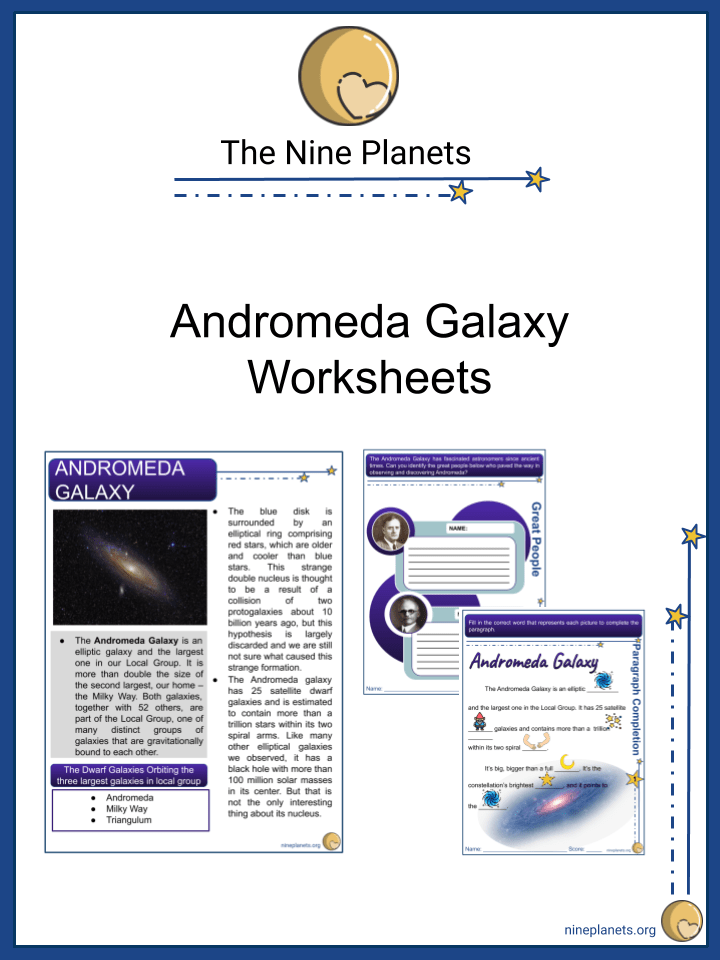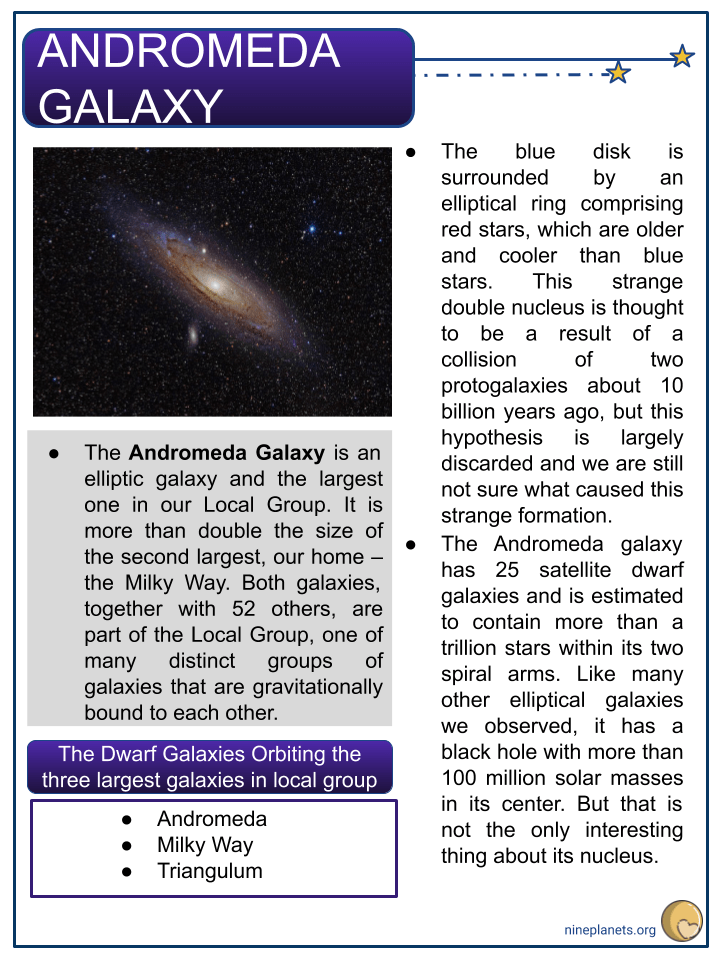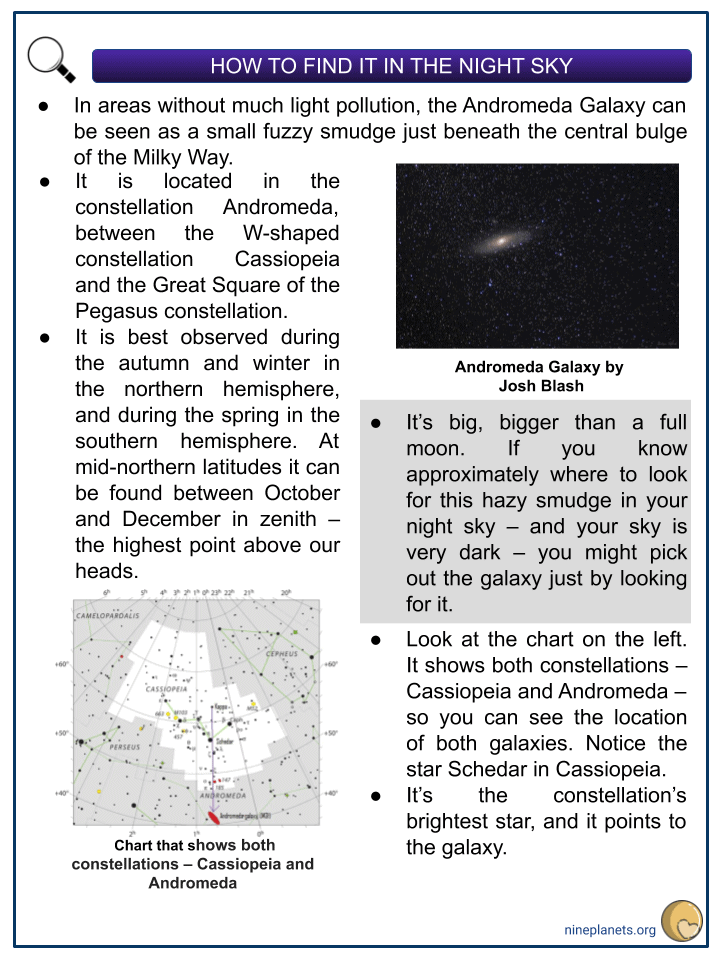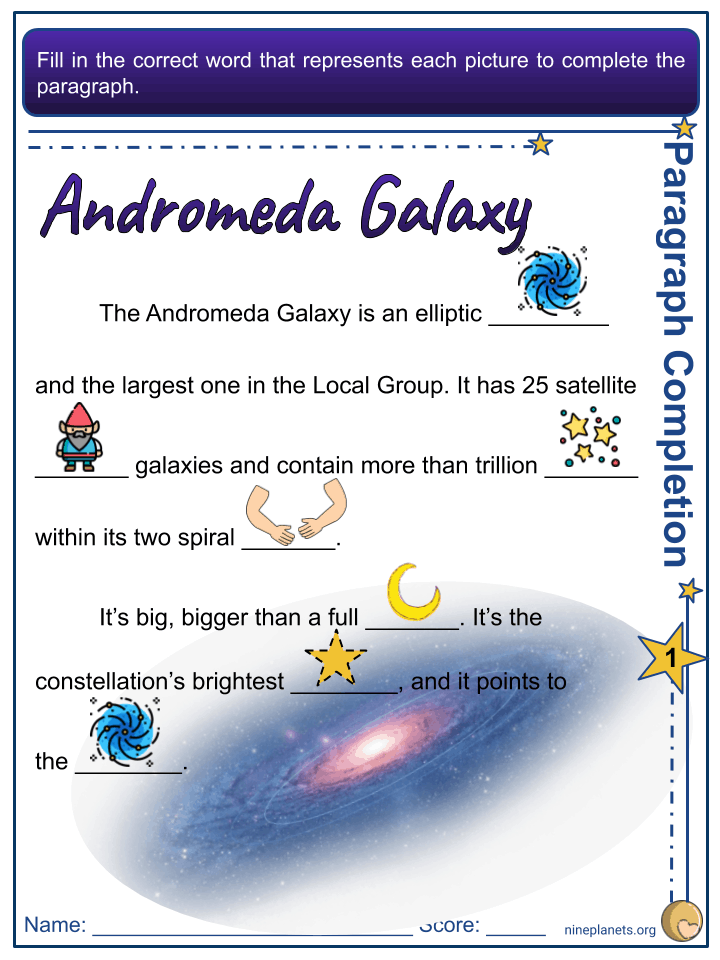Download Andromeda Galaxy Worksheets
Click the button below to get instant access to these premium worksheets for use in the classroom or at a home.

This worksheet can be edited by Premium members using the free Google Slides online software. Click the Edit button above to get started.
Download free sample
Not ready to purchase a subscription yet? Click here to download a FREE sample of this worksheet pack.
Resource Examples
Click any of the example images below to view a larger version.
Key Facts & Information
- The Andromeda Galaxy is an elliptic galaxy and the largest one in our Local Group. It is more than double the size of the second largest, our home – the Milky Way. Both galaxies, together with 52 others, are part of the Local Group, one of many distinct groups of galaxies that are gravitationally bound to each other.
- The blue disk is surrounded by an elliptical ring comprising red stars, which are older and cooler than blue stars. This strange double nucleus is thought to be a result of a collision of two protogalaxies about 10 billion years ago, but this hypothesis is largely discarded and we are still not sure what caused this strange formation.
- The Andromeda galaxy has 25 satellite dwarf galaxies and is estimated to contain more than a trillion stars within its two spiral arms. Like many other elliptical galaxies we observed, it has a black hole with more than 100 million solar masses in its center. But that is not the only interesting thing about its nucleus.
- The Dwarf Galaxies Orbiting the three largest galaxies in local group:
- Andromeda
- Milky Way
- Triangulum
Key Facts And Summary
- The Andromeda Galaxy is the largest galaxy in the Local Group, more than twice the size of the Milky Way.
- Astronomers have known about its existence, but it was thought that it was a nebular cloud within the Milky Way.
- Theory of “island universes” and the Andromeda being a galaxy outside our own was hypothesized as early as the 17th century.
- Edwin Hubble settled the debate in 1925 when he discovered a type of variable star inside the Andromeda.
- It is estimated to host more than a trillion stars, making it four times larger than the Milky Way.
- It has a strange structure in its center comprising a supermassive black hole, a disk of tightly packed blue young stars surrounded by a ring of older red stars.
- It is set on a collision course with the Milky Way in approximately 4.5 billion years.
- It is estimated to host more than a trillion stars, making it four times larger than the Milky Way.
- Distance: 2.5 million light- years (780 kiloparsecs)
- Diameter: 220 000 light- years
- Other designations: Messier 31, M31
- Constellation: Andromeda
How To Find It In The Night Sky
- In areas without much light pollution, the Andromeda Galaxy can be seen as a small fuzzy smudge just beneath the central bulge of the Milky Way.
- It is located in the constellation Andromeda, between the W-shaped constellation Cassiopeia and the Great Square of the Pegasus constellation.
- It is best observed during the autumn and winter in the northern hemisphere, and during the spring in the southern hemisphere. At mid-northern latitudes it can be found between October and December in zenith – the highest point above our heads.
- It’s big, bigger than a full moon. If you know approximately where to look for this hazy smudge in your night sky – and your sky is very dark – you might pick out the galaxy just by looking for it.
- Look at the chart on the left. It shows both constellations – Cassiopeia and Andromeda – so you can see the location of both galaxies. Notice the star Schedar in Cassiopeia.
- It’s the constellation’s brightest star, and it points to the galaxy.
History Of The Andromeda Galaxy
- The Andromeda has fascinated astronomers since ancient times. Some of the oldest records date all the way back to the 10th century. Up until the early 1900s, it was believed that the Andromeda was a nebula within the Milky Way galaxy. In fact, it was generally believed that all of the universe was contained within our galaxy.
- There were, however, speculations about the existence of extragalactic objects as early as the 17th century, most notably by a French mathematician Pierre Louis Maupertuis. He envisioned this beautiful and somewhat accurate notion of “island universes” with their own stars, planets and other celestial bodies.
- He was later quoted by the well-known German philosopher Immanuel Kant in his work Universal Natural History and Theory of the Heavens.
- The astronomer Heber Doust Curtis noticed a supernova within the Andromeda Galaxy in 1917, which prompted him to check earlier records. He found 11 instances of novae that were 10 times dimmer than other novae we observed in other parts of the sky. Based on the “island universes” theory, he calculated the distance to be around 500 000 light- years away. The existence of other galaxies and extragalactic objects outside the Milky Way once again became a subject of a great debate, known as – the Great Debate.
New Discoveries
- With the technological advancements over time, we were able to calculate something called transverse velocity, which indicates a colossal smash with our own galaxy in about 4 billion years.
- A team of researchers at the Space Telescope Science Institute were able to create a computer simulation depicting the process and the result of this collision.
- The results of these simulations were similar to those we observed in other galactic collisions, e.g. Antennae. Less than a 100 years after we proved it was, in fact, a galaxy, we were able to identify an exoplanet in the Andromeda Galaxy.
- Astronomers have discovered that our nearest big neighbor, the Andromeda Galaxy, is roughly the same size as the Milky Way.
- The Milky Way and Andromeda are two giant spiral galaxies in our local Universe, and light takes a cosmologically tiny two million years to get between them.
The Future Of Andromeda Galaxy
- Unlike other galaxies in our cosmic neighborhood that move away from us at an increasing rate due to the cosmic expansion, the Andromeda is set to collide with the Milky Way in about 4.5 billion years. It’s racing towards the Milky Way at the speed of 110 km.
- This monumental collision will most likely result in a bigger spiral galaxy some 6 billion years from now. The two supermassive black holes at the center of each galaxy will fall towards the center of the newly formed galaxy and merge to possibly produce a powerful quasar that shoots high-energy particles perpendicular to the plane of the galaxy.
- The shock wave of the two black holes merging might cause an increase in new star formation.
- Whether the Solar System will survive this violent head-on collision is hard to calculate and predict. With the average distance between stars being 100 billion times larger than the average size of a star, there might be some gravitational disruptions between the stars within the two galaxies, but direct collisions are unlikely. This means that our Sun will probably survive the collision.



